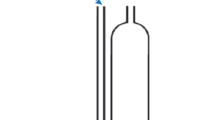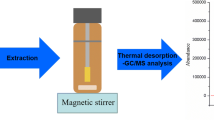Abstract
Ionic liquid foam floatation coupled with an ionic liquid-based homogeneous liquid–liquid microextraction (IF-IHLME) method was developed and compared with ionic liquid foam floatation coupled with an ionic liquid dispersive liquid–liquid microextraction (IF-IDLME) method by their application to the extraction, separation and determination of 17-α-estradiol, 17-β-estradiol-benzoate and quinestrol in environmental water samples. Based on the unique properties of ionic liquids (ILs), the advantages of foam floatation (FF) and the homogeneous liquid–liquid microextraction (HLLME) method were applied to the IF-IHLME method. The experimental parameters of the IF-IHLME method, including the salt concentration in the sample solution, type and volume of ILs, amount of ion-pairing agent (NH4PF6) and extraction time were evaluated. The limits of detection for 17-α-estradiol, 17-β-estradiol-benzoate and quinestrol were 0.04, 0.05 and 0.05 ng mL−1, respectively. When the proposed method was applied to the analysis of water samples, the recoveries of the analytes ranged from 95.5 to 114.6%, and relative standard deviations were lower than 8.00%. By comparison, both of these two proposed separation and extraction procedures can be successfully applied to the water sample pretreatment for HPLC detection, but the enrichment factor of IF-IHLME is much higher than that of IF-IDLME, which ranged from 5334 to 5558. These two methods requiring no organic solvent and inexpensive instrumentation in the experiment process were both environmentally friendly. Different properties of ionic liquids were applied in these two methods, for example, foam and extraction, and the property of mutual transformation between the hydrophilic and hydrophobic phase was applied in the IF-IHLME method; foam, extraction and hydrophobic properties of ILs were applied in the IF-IDLME method. These two methods were similar but not the same. Based on the unique properties of ionic liquids, the application of foam floatation and liquid–liquid microextraction was widened and has many possibilities.
Graphical abstract






Similar content being viewed by others
References
Heydari R, Hosseini M, Zarabi S (2015) A simple method for determination of carmine in food samples based on cloud point extraction and spectrophotometric detection. Mol Biomol Spectrosc 150:786–791
Jessen F, Wulff T (2015) Triton X-114 cloud point extraction to subfractionate blood plasma proteins for two-dimensional gel electrophoresis. Anal Biochem 485:11–17
Lou Z, Wang H, Zhu S, Chen S, Zhang M, Wang Z (2012) Ionic liquids based simultaneous ultrasonic and microwave assisted extraction of phenolic compounds from burdock leaves. Anal Chim Acta 716:28–33
Farajzadeh MA, Feriduni B, Mogaddam MRA (2015) Development of counter current salting-out homogenous liquid–liquid extraction for isolation and preconcentration of some pesticides from aqueous samples. Anal Chim Acta 885:122–131
Farajzadeh MA, Mohebbi A, Feriduni B (2016) Development of continuous dispersive liquid-liquid microextraction performed in home-made device for extraction and preconcentration of aryloxyphenoxy-propionate herbicides from aqueous samples followed by gas chromatography–flame ionization detection. Anal Chim Acta 920:1–9
Simão V, Merib J, Dias AN, Carasek E (2016) Novel analytical procedure using a combination of hollow fiber supported liquid membrane and dispersive liquid–liquid microextraction for the determination of aflatoxins in soybean juice by high performance liquid chromatography–fluorescence detector. Food Chem 196:292–300
Martín J, Santos JL, Aparicio I, Alonso E (2015) Determination of hormones, aplasticizer, preservatives, perfluoroalkylated compounds, and a flame retardant in water samples by ultrasound-assisted dispersive liquid–liquid microextraction based on the solidification of a floating organic drop. Talanta 143:335–343
Farajzadeh MA, Afshar Mogaddam MR, Rezaee Aghdam S, Nouri N, Bamorrowat M (2016) Application of elevated temperature-dispersive liquid–liquid microextraction for determination of organophosphorus pesticides residues in aqueous samples followed by gas chromatography–flame ionization detection. Food Chem 212:198–204
Gao SQ, Jin HY, You JY, Ding Y, Zhang N, Wang Y, Ren RR, Zhang R, Zhang HQ (2011) Ionic liquid-based homogeneous liquid–liquid microextraction for the determination of antibiotics in milk by high-performance liquid chromatography. J Chromatogr A 1218:7254–7263
Guan W, Zhu T, Wang Y, Zhang Z, Jin Z, Wang C, Bai F (2016) Efficacy of head space solid-phase microextraction coupled to gas chromatography–mass spectrometry method for determination of the trace extracellular hydrocarbons of cyanobacteria. J Chromatogr B Anal Technol Biomed Life Sci 1029–1030:113–120
Muniraj S, Yan C, Shi H, Ponnusamy VK, Jen J (2012) Determination of ammonium in aqueous samples using new headspace dynamic in-syringe liquid-phase microextraction with in situ derivitazation coupled with liquid chromatography–fluorescence detection. Anal Chim Acta 754:54–60
Šrámková I, Horstkotte B, Sklenářová H, Solich P, Kolev SD (2016) A novel approach to lab-in-syringe head-space single-drop microextraction and on-drop sensing of ammonia. Anal Chim Acta 934:132–144
Zhang H, Chen X, Jiang X (2011) Determination of phthalate esters in water samples by ionic liquid cold-induced aggregation dispersive liquid–liquid microextraction coupled with high-performance liquid chromatography. Anal Chim Acta 689:137–142
Baghdadi M, Shemirani F (2008) Cold-induced aggregation microextraction: a novel sample preparation technique based on ionic liquids. Anal Chim Acta 613:56–63
Galán-Cano F, Lucena R, Cárdenas S, Valcárcel M (2012) Ionic liquid based in situ solvent formation microextraction coupled to thermal desorption for chlorophenols determination in waters by gas chromatography/mass spectrometry. J Chromatogr A 1229:48–54
Baghdadi M, Shemirani F (2009) In situ solvent formation microextraction based on ionic liquids: a novel sample preparation technique for determination of inorganic species in saline solutions. Anal Chim Acta 634:186–191
Liu R, Liu J, Yin Y, Hu X, Jiang G (2009) Ionic liquids in sample preparation. Anal Bioanal Chem 393:871–883
Sun P, Armstrong DW (2010) Ionic liquids in analytical chemistry. Anal Chim Acta 661:1–16
Wang Z, He M, Jiang C, Zhang F, Du S, Feng W, Zhang H (2015) Matrix solid-phase dispersion coupled with homogeneous ionic liquid microextraction for the determination of sulfonamides in animal tissues using high-performance liquid chromatography. J Sep Sci 38:4127–4135
Ebrahimpour B, Yamini Y, Esrafili A (2013) Acid-induced homogenous liquid-phase microextraction: application of medium-chain carboxylic acid as extraction phase. J Sep Sci 36:1493–1499
Hosseini MH, Rezaee M, Akbarian S, Mizani F, Pourjavid MR, Arabieh M (2013) Homogeneous liquid–liquid microextraction via flotation assistance for rapid and efficient determination of polycyclic aromatic hydrocarbons in water samples. Anal Chim Acta 762:54–60
Xiao Y, Zhang H (2012) Homogeneous ionic liquid microextraction of the active constituents from fruits of Schisandra chinensis and Schisandra sphenanthera. Anal Chim Acta 712:78–84
Yousefi S, Shemirani F (2010) Development of a robust ionic liquid-based dispersive liquid–liquid microextraction against high concentration of salt for preconcentration of trace metals in saline aqueous samples: application to the determination of Pb and Cd. Anal Chim Acta 669:25–31
Song Y, Wu L, Li N, Hu M, Wang Z (2015) Utilization of a novel microwave-assisted ionic liquid-based homogeneous liquid–liquid microextraction method for the determination of Sudan dyes in red wines. Talanta 135:163–169
Wang Z, Cao B, Yu A, Zhang H, Qiu F (2015) Ultrasound-assisted ionic liquid-based homogeneous liquid–liquid microextraction high-performance liquid chromatography for determination of tanshinones in Salvia miltiorrhiza Bge. root. J Pharm Biomed Anal 104:97–104
Wang Z, Zhang L, Li N, Lei L, Shao M, Yang X, Song Y, Yu A, Zhang H, Qiu F (2014) Ionic liquid-based matrix solid-phase dispersion coupled with homogeneous liquid–liquid microextraction of synthetic dyes in condiments. J Chromatogr A 1348:52–62
Hu H, Liu B, Yang J, Lin Z, Gan W (2016) Sensitive determination of trace urinary 3-hydroxybenzo[a]pyrene using ionic liquids-based dispersive liquid–liquid microextraction followed by chemical derivatization and high performance liquid chromatography-high resolution tandem mass spectrometry. J Chromatogr B Anal Technol Biomed Life Sci 1027:200–206
Zhang J, Gao H, Peng B, Li S, Zhou Z (2011) Comparison of the performance of conventional, temperature-controlled, and ultrasound-assisted ionic liquid dispersive liquid–liquid microextraction combined with high-performance liquid chromatography in analyzing pyrethroid pesticides in honey samples. J Chromatogr A 1218:6621–6629
Bai YP, Zhao L, Qu C, Meng X, Zhang HQ (2009) Microwave degradation of floatation-enriched ginsenoside extract from Panax quinquefolium L. leaf. J Agric Food Chem 57:10252–10260
Zhang R, Zhang HQ, Wu LW, You JY, Bai YP (2010) Foam floatation-SPE for separation and concentration of trace ginsenosides. Chromatographia 72:39–46
Zhang R, Li N, Wang CL, Bai YP, Ren RB, Gao SH, Yu W, Zhao T, Zhang HQ (2011) Ionic liquid foam floatation coupled with solid phase extraction for separation and determination of hormones by high-performance liquid chromatography. Anal Chim Acta 704:98–109
Zhang R, Wang CL, Yue QH, Zhou TC, Li N, Zhang H, Hao XK (2014) Ionic liquid foam floatation coupled with ionic liquid dispersive liquid–liquid microextraction for the separation and determination of estrogens in water samples by high-performance liquid chromatography with fluorescence detection. J Sep Sci 37:3133–3141
Tang T, Qian K, Shi T, Wang F, Li P, Li J, Cao Y (2012) Photodegradation of quinestrol in waters and the transformation products by UV irradiation. Chemosphere 89:1419–1425
Regal P, Vázquez BI, Franco CM, Cepeda A, Fente C (2009) Quantitative LC–MS/MS method for the sensitive and simultaneous determination of natural hormones in bovine serum. J Chromatogr B 877:2457–2464
Anderson DS, Heeney MM, Roth U, Menzel C, Fleming MD, Steen H (2010) High-throughput matrix-assisted laser desorption ionization-time-of-flight mass spectrometry method for quantification of hepcidin in human urine. Anal Chem 82:1551–1555
Rice SL, Hale RC (2009) Parameters for ultra-performance liquid chromatographic/tandem mass spectrometric analysis of selected androgens versus estrogens in aqueous matrices. Anal Chem 81:6716–6724
Yao C, Anderson JL (2009) Dispersive liquid–liquid microextraction using an in situ metathesis reaction to form an ionic liquid extraction phase for the preconcentration of aromatic compounds from water. Anal Bioanal Chem 395:1491–1502
Hu YF, Zhang M, Tong CL, Wu JM, Liu WP (2013) Enrichment of steroid hormones in water with porous and hydrophobic polymer-based SPE followed by HPLC-UV determination. J Sep Sci 36:3321–3329
D’Orazio G, Asensio-Ramos M, Hernández-Borges J, Fanali S, Rodríguez-Delgado MÁ (2014) Estrogenic compounds determination in water samples by dispersive liquid–liquid microextraction and micellar electrokinetic chromatography coupled to mass spectrometry. J Chromatogr A 1344:109–121
Chang CC, Huang SD (2010) Determination of the steroid hormone levels in water samples by dispersive liquid–liquid microextraction with solidification of a floating organic drop followed by high-performance liquid chromatography. Anal Chim Acta 662:39–43
Wang Y, You JY, Ren RB, Xiao Y, Gao SQ, Zhang HQ, Yu AM (2010) Determination of triazines in honey by dispersive liquid–liquid microextraction high-performance liquid chromatography. J Chromatogr A 1217:4241–4246
Acknowledgements
This work was supported by the National Natural Science Foundation of China (no. 81401744).
Author information
Authors and Affiliations
Corresponding author
Ethics declarations
Conflict of interest
The authors declare that our research is in compliance with ethical standards, there is no conflict of interest regarding the publication of this paper, and our research did not involving human participants or animals.
Additional information
R. Zhang and X. Cheng contributed equally to this work.
Rights and permissions
About this article
Cite this article
Zhang, R., Cheng, X., Guo, J. et al. Comparison of Two Ionic Liquid-Based Pretreatment Methods for Three Steroids' Separation and Determination in Water Samples by HPLC. Chromatographia 80, 237–246 (2017). https://doi.org/10.1007/s10337-016-3215-9
Received:
Revised:
Accepted:
Published:
Issue Date:
DOI: https://doi.org/10.1007/s10337-016-3215-9




